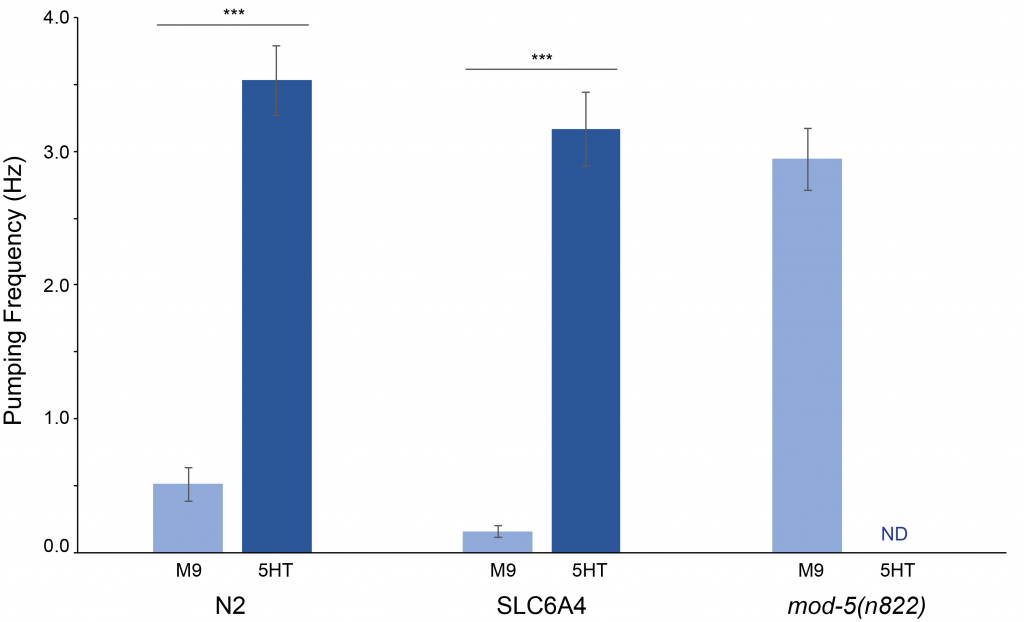Effects of serotonin in mammals can be modeled using pharyngeal pumping phenotypes in C. elegans
Terra Hiebert, Ph. D.
Serotonin is well known for being important in the regulation of people’s mood. Here in the Pacific Northwest, our long overcast winters have made many of us very familiar with the mood improving effects of serotonin. SSRIs, or selective serotonin reuptake inhibitors, are the most common class of antidepressants prescribed in the USA. However, serotonin (5HT) is a neurotransmitter with widespread regulatory effects in humans, from contractions of the gut to sensory perception in the brain, making it a very important neurotransmitter to study. We recently found that we can model the serotonin biochemical pathway using a sensitive measure for pharyngeal pumping in C. elegans.
Let’s start at the beginning. Serotonin regulates pharyngeal pumping in C. elegans. In fact, we often use exogenous 5HT to elicit sustained pharyngeal pumping for electropharyngeogram (EPG) recordings (see Serotonin induced pharyngeal pumping in C. elegans). The key enzyme involved in the biosynthesis of 5HT is tryptophan hydroxylase, which is encoded by the gene tph-1 (see Fig. 1A). Since 5HT stimulates pumping in C. elegans, we expected tph-1 mutants, producing less 5HT, to display a reduction in pharyngeal pumping (Sze et al., 2000; Song and Avery 2012). This is exactly what we observed using the NemaMetrix’s ScreenChip System. When we measured pharyngeal pumping in tph-1 mutants in the presence of bacterial food, we found a significant reduction in pumping frequency when compared to control animals (Fig. 1B; Hiebert et al., 2017).
 Figure 1. A) Simplified neuromuscular junction depicts endogenous 5HT pathway, including synthesis (e.g., tph-1) and reuptake (e.g., mod-5). Mean pharyngeal pumping frequency in tph-1 mutants in the presence of bacterial food (OP50); (B) and two mod-5 mutants in the absence of pumping stimulus (C). *** p < 0.0001.
Figure 1. A) Simplified neuromuscular junction depicts endogenous 5HT pathway, including synthesis (e.g., tph-1) and reuptake (e.g., mod-5). Mean pharyngeal pumping frequency in tph-1 mutants in the presence of bacterial food (OP50); (B) and two mod-5 mutants in the absence of pumping stimulus (C). *** p < 0.0001.
As we discussed, tryptophan hydroxylase facilitates the synthesis of 5HT, which is eventually released at the synaptic cleft. On the other hand, the re-uptake of 5HT from the synapse is facilitated by mod-5. Defects to this 5HT transporter result in an accumulation of 5HT at the synaptic cleft. Therefore, in mod-5 loss-of-function mutants, we would expect – you guessed it – more pumping. We compared two mod-5 mutants and found that both displayed higher pumping rates than control N2s without any pumping stimulus at all (Fig. 1C; Hiebert et al., 2017).
Can you rescue the rate of pumping when the transporter function is restored?
We collaborated with Knudra Transgenics to further investigate the mod-5 5HT reuptake transporter. Following our observation of a pharyngeal phenotype for mod-5 loss-of-function mutants (Fig. 1C, above), Knudra created a ‘humanized’ gain-of-function strain. The human mod-5 homologue, SLC6A4, was added to the mod-5 transporter, under a promoter for strong expression in the pharynx, using transposon-mediate gene insertion (MosSCI).
This resulted in the expression of SL6A4, and restored pharyngeal pumping in mod-5 worms to that which is observed in control N2 animals (Fig. 2). In the absence of pumping stimulus (M9 buffer only), pharyngeal pumping is low when compared to mod-5 null mutants (e.g., mod-5(n822)), as endogenous 5HT is removed from the synaptic cleft (light blue bars, Fig. 2). Moreover, exogenous 5HT restores pumping to that which is observed in control N2 animals (dark blue bars, Fig. 2). We also observed pumping rates for SLC64A worms that were even lower than N2 controls with food (bacteria, E. coli OP50) as pumping stimulus (data not shown), which is likely due to the overexpression of the mod-5 homologue resulting from the insertion method (i.e., overexpression leads to an even faster clearance of 5HT from the synaptic cleft). With the results from these ‘humanized’ worms, we have now shown that pharyngeal pumping is reduced when less 5HT is present at the synaptic cleft resulting from inhibition of synthesis or increased reuptake. Figure 2. A comparison of mean pharyngeal pumping frequency in the ‘humanized’ mod-5 strain (SLC6A4), N2 control animals, and mod-5(n822) loss-of-function mutants; data shown for both M9 (light blue bars) and 5HT (10mM, dark blue bars), where available. *** p < 0.0001.
Figure 2. A comparison of mean pharyngeal pumping frequency in the ‘humanized’ mod-5 strain (SLC6A4), N2 control animals, and mod-5(n822) loss-of-function mutants; data shown for both M9 (light blue bars) and 5HT (10mM, dark blue bars), where available. *** p < 0.0001.
System Overview Request More Info
Our C. elegans genome-editing services provide precise and efficient solutions to unlock the potential of your research. Please do not hesitate to contact us to learn more about our services.

